
Protective clothing reduces heat stress
Scientists at the Hohenstein Institute in Bönnigheim, in conjunction with several industry partners, have developed special functional underwear for fire-fighting deployment teams. The functional underwear was developed under the framework of the research project (AiF-Nr. 16676 N), which was based on a study from 2003, which said that 49% of fatalities amongst fire-fighters in the USA were attributable to heat stress.

26th October 2012
Innovation in Textiles
|
Bönnigheim
Scientists at the Hohenstein Institute in Bönnigheim, in conjunction with several industry partners, have developed special functional underwear for fire-fighting deployment teams.
The functional underwear was developed under the framework of the research project (AiF-Nr. 16676 N), which was based on a study from 2003, which said that 49% of fatalities amongst fire-fighters in the USA were attributable to heat stress.

According to the Hohenstein scientists, whereas outer clothing as part of personal protective clothing (PPE) has been constantly improved and further fine-tuned over the last few decades to comply with detailed specifications, very little attention has to date been paid to the clothing layers worn beneath.
“In the sport and leisure sector these finely-tuned clothing layers worn on top of each other and providing optimum support to the physiological processes of the wearer have now become customary. However for the fire services the question of ‘underneath’ has largely been viewed as a private matter despite the fact that they are subject to environmental conditions and physical exertion when in deployment that far exceed those in professional sport,” the researchers say.

In the development of a clothing system for fire-fighters, project manager Dr. Bianca Wölfling from the team of Dr. Jan Beringer, therefore had the specific objective of supporting the body's own cooling function in the best way possible through the fast diversion of sweat whilst simultaneously ensuring good heat insulation.
"The environmental temperature and the degree of activity of fire-fighters varies greatly depending on the type of deployment. This balancing act can only be achieved via a clothing system based on the onion-skin principle,” Dr. Wölfling says. Accordingly the scientists researched the placement of clothing layers on top of each other which enabled them to solve the complex requirements.
In the laboratory tests two material variants proved to be particularly effective when worn as the clothing layer next to the skin. These were double-face materials with a hydrophobic (water-repellent) inside combined with a hydrophilic (water-attracting) outside. The resulting fast sweat transport away from the body was again said to be significantly improved by the researchers in comparison to functional sports textiles. The same applies for the second material variant, which was designed to be completely hydrophobic.

“For the next clothing layer, which could in future replace the usual ‘station wear’ of professional fire services, the project team investigated different membrane materials for their ability to absorb sweat and transport it away from the body. Attention was also paid to the heat insulation of this clothing layer. This is very important when using fire extinguishers as an additional barrier against the heat of a fire source and also as cold protection in other rescue scenarios,” Dr. Wölfling explains.
In accordance with the title of the research project ‘Development of physiologically functional and industrially reprocessable fire-resistant clothing for fire-fighters whilst retaining the protection function and fitness for purpose' the main emphasis of the investigation into outer clothing was the compliance of norms and specifications in relation to flame retardation and warning effectiveness.
So that the workwear clothing can be used for as long as possible, these protective effects must not be significantly impaired through any reprocessing, such as washing and drying under the extreme mechanical and thermal conditions of commercial laundries. Therefore the scientists also compared the different materials in relation to these aspects and defined an optimum outer fabric design.
In addition to the laboratory investigations using what is referred to as the Skin Model and the thermal manikin ‘Charlie’ who was used to investigate the thermal-physiological properties of the individual clothing layers and their interplay with each other, the Hohenstein scientists also worked with some test persons.
They assisted at the start of the project to test customary fire-fighter suits under real conditions in the climate chamber. The aim here was to obtain subjective assessments of the wear comfort and physiological measurement values and then to add these to the objective investigation results established in the laboratory.
The results revealed that fire-fighters wearing the usual suits worn to date start to sweat with moderate physical movement at an environmental temperature of 18°C. Through the wearer trials carried out at the end of the project, the objective measurement results of the optimised products were validated by the personal assessment of the test persons.
Dr. Bianca Wölfling
Eschler Textil GmbH, Fuchshuber Techno-Tex GmbH, W.L. Gore & Associates GmbH, Sympatex Technologies, Trans-Textil GmbH, Lion Apparel, S Gard Schutzkleidung Hubert Schmitz GmbH & Co., KG, Watex Schutzbekleidungs GmbH, Tempex GmbH.

Business intelligence for the fibre, textiles and apparel industries: technologies, innovations, markets, investments, trade policy, sourcing, strategy...
Find out more